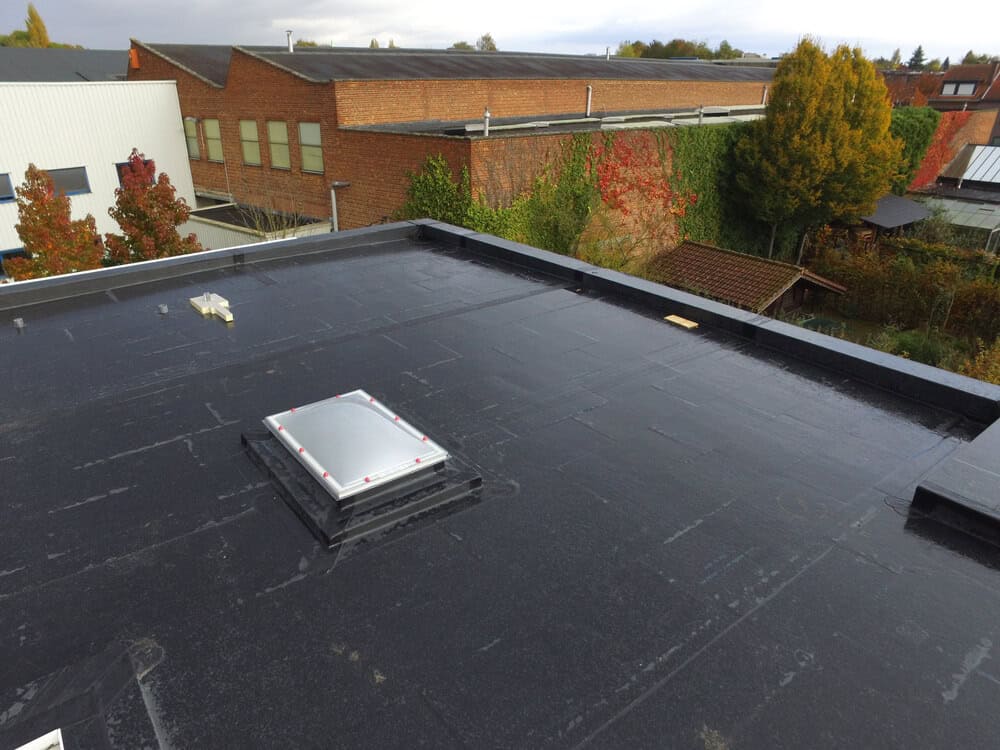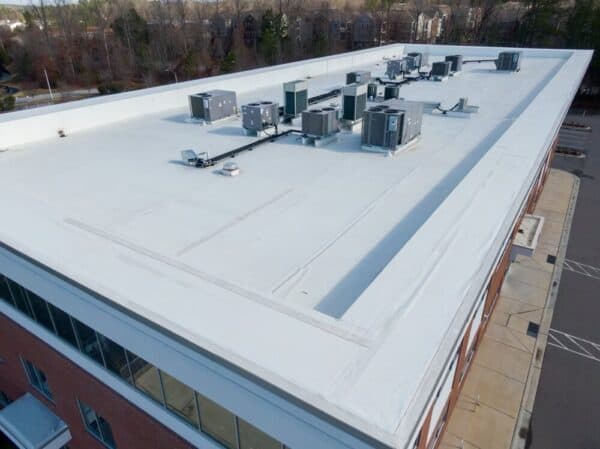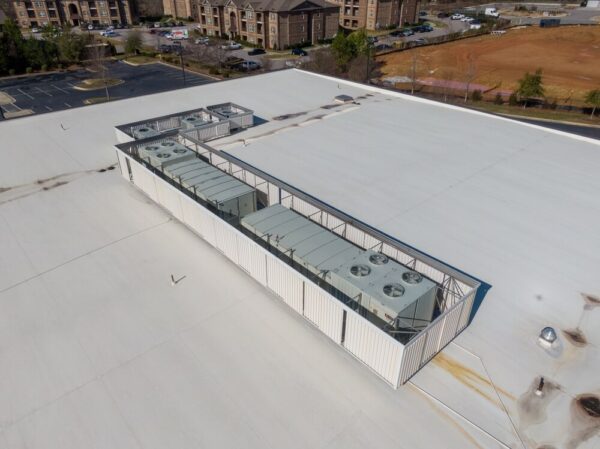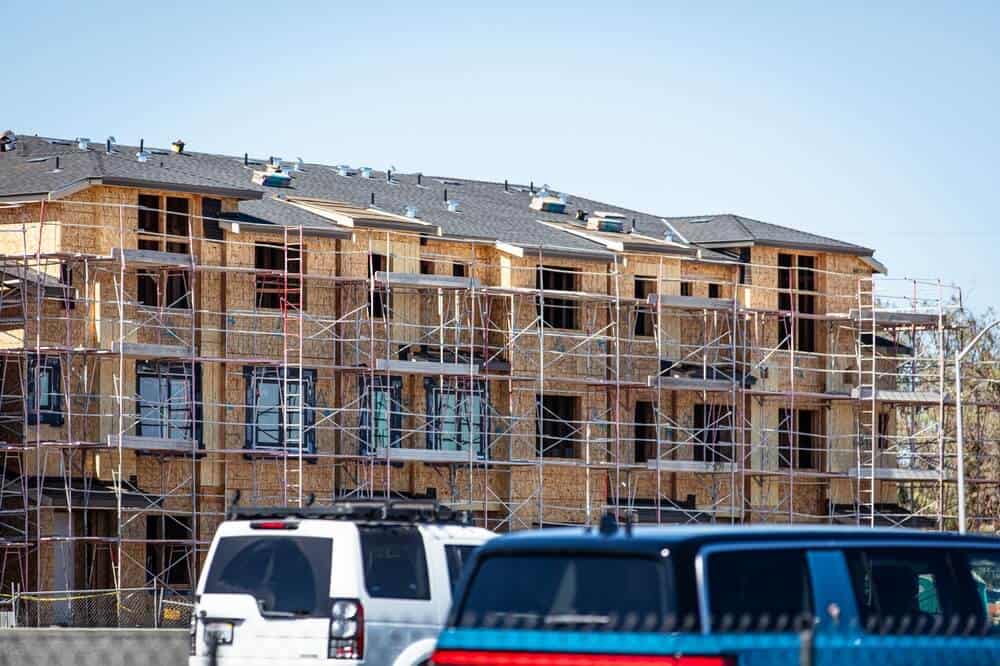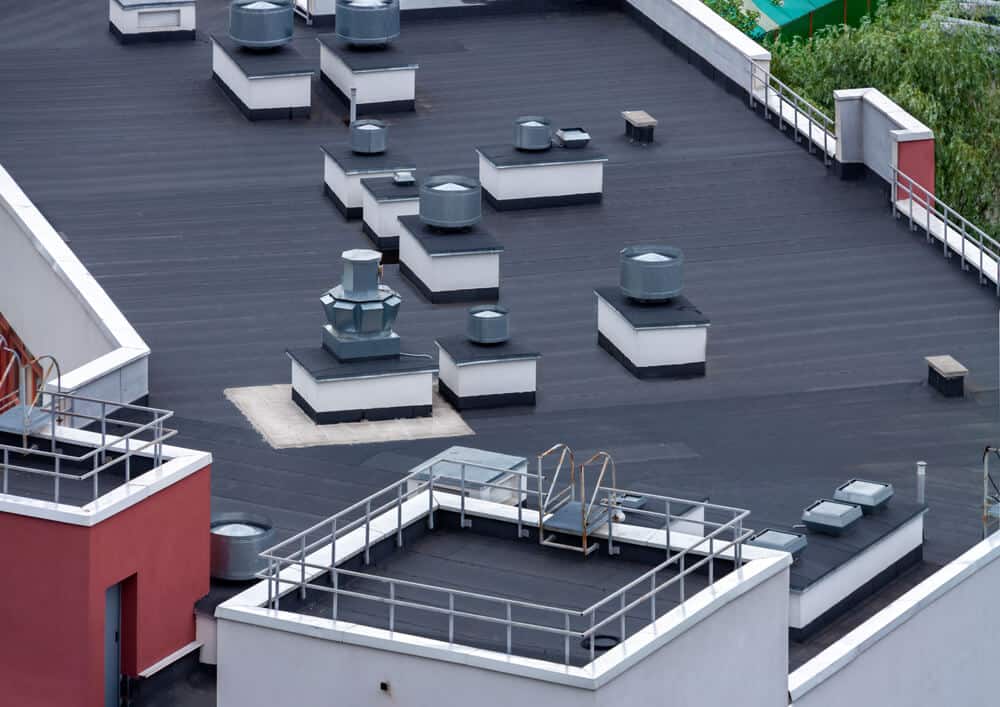Flat and low-sloped roofs can be tricky to deal with. Water doesn’t shed as quickly as a pitched roof, rendering some roofing systems useless against water penetration. Also, these roofs are often used for building equipment or eco-friendly green or blue roofs. For these reasons, a flat or low slope roof needs the right materials properly installed by a certified professional.
Two of the most popular options are EPDM and TPO roofing materials. These single-ply roofing systems are membranes that prevent water penetration, protect the building, and provide some eco-friendly benefits. In this guide, we’ll compare EPDM roofing vs TPO to discuss their pros, cons, and the costs of both roofing system options.
Contents
- 1 What are EPDM and TPO Roofing Systems?
- 2 Pros and Cons of EPDM Membrane
- 3 Pros and Cons of TPO Roofing
- 3.1 Pro: It’s Highly Energy-Efficient
- 3.2 Pro: It’s Durable Against UV Radiation, Ozone, and Chemical Exposure
- 3.3 Pro: It’s Lightweight
- 3.4 Pro: It’s Affordable
- 3.5 Pro: It Can Be Recyclable
- 3.6 Pro: It’s Resistant to Mold and Algae
- 3.7 Pro: It’s Low Maintenance
- 3.8 Con: Relatively New Product
- 3.9 Con: Quality Varies
- 4 Comparing EPDM Roofing vs TPO Costs
- 5 Let AAA Roofing Guide You On the EPDM Roofing vs TPO Debate
What are EPDM and TPO Roofing Systems?
Both EPDM and TPO roofing systems are roof membranes that protect the roof from water penetration, UV rays, harsh weather, and other hazards.
Both materials are referred to as a type of single-ply roofing membrane because they’re installed as one layer of material, rather than a BUR (built-up roof) which requires sandwiched layers of different materials.
Ethylene Propylene Diene Monomer and Thermoplastic Polyolefin come in long strips coiled into rolls. They’re rolled out onto the roof, with the seams overlapping. There are several installation options for both TPO and EPDM, including mechanically attached, adhered, and ballasted.
EPDM Roofing System
EPDM stands for Ethylene Propylene Diene Monomer, and it’s a synthetic rubber material that’s very durable.
EPDM roofing membranes have been in use since the 1960s and are popular choices for commercial and industrial buildings. It’s highly elastic, stretching up to 300% in any direction before retaking its original shape. EPDM membrane comes in white and black, both of which have benefits and drawbacks.
TPO Roofing System
TPO stands for Thermoplastic Polyolefin, which is a blend of polypropylene and ethylene-propylene rubber. It’s a relatively new material that’s durable, highly energy-efficient, and waterproof. TPO roofs are resistant to UV rays and chemical exposure, and they’re available in multiple colors.
Pros and Cons of EPDM Membrane
EPDM roofing has been a popular roofing material for decades, so its pros and cons are well known. The following are some significant upsides and downsides of using EPDM for a commercial roof.
It’s worth noting that some of their benefits (and drawbacks) overlap as TPO and EPDM single-ply roofing membranes share many similarities—both good and bad.
Pro: It Lasts a Long Time
EPDM roofing membranes are one of the longest-lasting materials for flat roofs and semi-flat commercial buildings. With proper installation and mild conditions, EPDM roofing systems will last up to 40 years—sometimes longer.
Pro: It Can Absorb Heat
One of the benefits that EPDM roofs have over some other roofing systems is their ability to absorb heat energy from the sun. While that might be a drawback in hot climates, in cold climates, this roofing material can actually reduce heating costs.
Pro: Installing an EPDM Roof is Affordable and Relatively Easy
EPDM membranes are relatively affordable compared to other commercial roofing materials. And, since it’s lightweight and easy to install, installation is typically affordable. Crews roll out the sheets, flash around protrusions and walls, and seal the seams with tape or liquid adhesives.
The sheets can either be fully adhered, mechanically attached with plates, or ballasted. Ballasted EPDM systems are held down to the roof deck with concrete pavers, stones, and gravel.
Pro: It’s 100% Recyclable
EPDM roofing is entirely recyclable. While the production of the material itself isn’t all that eco-friendly thanks to its reliance on fossil fuels, an EPDM membrane can last for decades and can ultimately be recycled into more EPDM materials.
Pro: It’s Low Maintenance
Beyond regular cleaning and occasional inspections, EPDM roofing systems are low maintenance. They don’t need to be sealed or coated and punctures are easy to repair.
Con: Shrinking Can Lead to Cracking
EPDM roofs tend to shrink over time, especially with repeated exposure to extreme cold. This shrinking has been known to cause cracking, compromising the roof’s ability to resist weather and elements.
Con: Seam Adhesion Can Be an Issue
EPDM roofing has seams that are sealed with bonding adhesives or tape. This makes for an easy, safe installation, but the seams can be less durable than welded seams, such as those in a TPO roofing system.
Con: Color Options Are Limited
There aren’t many color options available. Most EPDM roofs are black, with some being available in a more reflective white finish. Outside of those two colors (and white being relatively rare anyway), there aren’t many roof color options to choose from.
Pros and Cons of TPO Roofing
TPO membranes are relatively new, only becoming common over the last 20 years. However, it’s been a popular choice, particularly in the warmer climates, so we know quite a bit about its upsides and drawbacks. Here are some of the most common pros and cons of TPO roofing.
Pro: It’s Highly Energy-Efficient
A TPO roofing system can improve a building’s energy efficiency. It’s highly reflective, preventing the sun’s rays from penetrating the building and increasing the cooling costs. In warmer climates, a TPO roof can lead to significant savings on large commercial properties.
Pro: It’s Durable Against UV Radiation, Ozone, and Chemical Exposure
TPO’s makeup allows it to resist many hazards that other commercial roof materials are susceptible to. For instance, TPO membranes are resistant to UV rays, ozone, and exposure to chemicals. Roofs likely to be exposed to chemicals, oils, and grease can benefit significantly from TPO systems.
Pro: It’s Lightweight
Rolls of TPO membranes are lightweight. They’re easy to maneuver around a roof, but it also means that the structure itself doesn’t need reinforcing like some other commercial roofing systems.
Pro: It’s Affordable
Like EPDM, installing a TPO roof is relatively affordable. The material is fairly inexpensive and the labor required to install it is reasonable. The seams are heat-welded rather than glued or taped, so while there are some specialized tools required, the process is relatively straightforward.
Pro: It Can Be Recyclable
TPO membranes can be recyclable, which is an eco-friendlier option than disposal. However, there aren’t as many facilities available to recycle TPO membranes as there are for EPDM, so it can require additional trucking and handling.
Pro: It’s Resistant to Mold and Algae
One significant benefit of TPO is that it resists mold growth and algae. In areas in close proximity to trees, or on shady sides of buildings, this can help the roof stay cleaner longer and prevent unwanted organic growth.
Pro: It’s Low Maintenance
TPO roofing is low maintenance, so property owners don’t have to worry about an in-depth scheduling of inspections and service. Regular cleaning and relative ease of patching make it a great option for most commercial roofs.
Also, since the material is lightweight, it can be installed in wider strips, creating fewer seams. The seams that do exist are heat welded, providing durable, long-lasting seals that generally outperform tape or adhesives.
Con: Relatively New Product
One of the issues with TPO membrane is that it’s a relatively new product, so the track record just isn’t as long as EPDM. This isn’t necessarily a con but a point worth considering.
Con: Quality Varies
The quality of the TPO products provided varies based on the manufacturer. Some rolls of TPO are more durable and longer lasting than others. For this reason, it’s critical to choose a roofing installer that uses credible, high-quality brands.
Comparing EPDM Roofing vs TPO Costs
When it comes to costs, EPDM and TPO roofs are actually quite close in pricing. The materials, installation, and applications are similar, so the cost of installing these single-ply materials is competitive, whether you choose a TPO or EPDM roofing system.
Similar doesn’t necessarily mean the same, however. TPO does cost just slightly more to install on a commercial building than EPDM. The reasons are that the material is slightly more expensive and the process of heat welding the seams requires more expertise than using adhesive tapes of solvents.
However, it’s worth noting that both TPO and EPDM roofing products offer excellent value. And, their energy efficiency does help offset some of the initial cost of installation, regardless of how affordable they might be.
Let AAA Roofing Guide You On the EPDM Roofing vs TPO Debate
If you’re in the market for single-ply commercial roofing, AAA Roofing can answer all of your questions. We are an experienced roofing contractor with more than 35 years in the roofing industry. Our roofing professionals proudly and properly install EPDM, TPO, PVC, and other membranes on commercial buildings.
AAA Roofing offers exceptional customer service, helping customers determine the best roofing materials for their buildings’ needs and their budgets. Our customers receive a detailed inspection report and the guidance necessary to make the best possible decision for all of their roofing needs.


